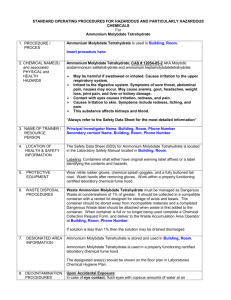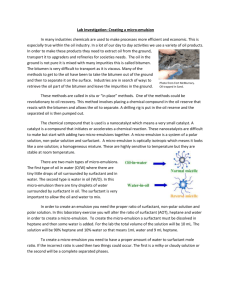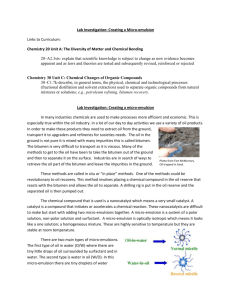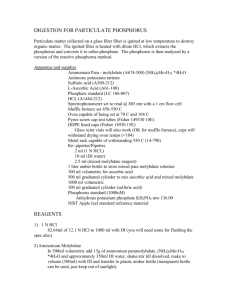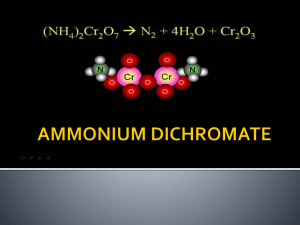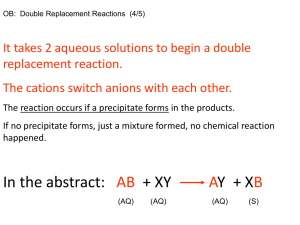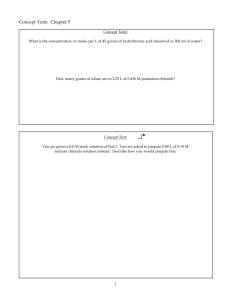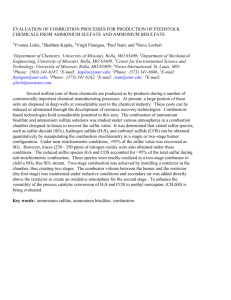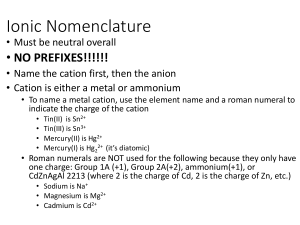Lab Investigation: Affecting Micro-emulsions TR
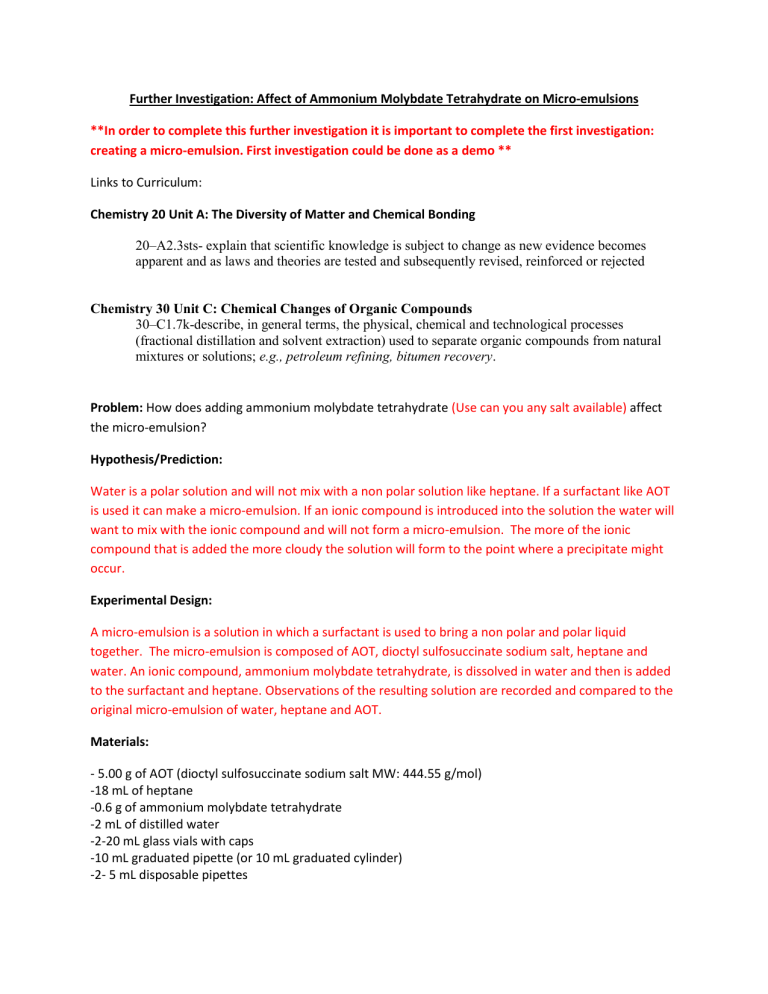
Further Investigation: Affect of Ammonium Molybdate Tetrahydrate on Micro-emulsions
**In order to complete this further investigation it is important to complete the first investigation: creating a micro-emulsion. First investigation could be done as a demo **
Links to Curriculum:
Chemistry 20 Unit A: The Diversity of Matter and Chemical Bonding
20–A2.3sts- explain that scientific knowledge is subject to change as new evidence becomes apparent and as laws and theories are tested and subsequently revised, reinforced or rejected
Chemistry 30 Unit C: Chemical Changes of Organic Compounds
30–C1.7k-describe, in general terms, the physical, chemical and technological processes
(fractional distillation and solvent extraction) used to separate organic compounds from natural mixtures or solutions; e.g., petroleum refining, bitumen recovery .
Problem: How does adding ammonium molybdate tetrahydrate (Use can you any salt available) affect the micro-emulsion?
Hypothesis/Prediction:
Water is a polar solution and will not mix with a non polar solution like heptane. If a surfactant like AOT is used it can make a micro-emulsion. If an ionic compound is introduced into the solution the water will want to mix with the ionic compound and will not form a micro-emulsion. The more of the ionic compound that is added the more cloudy the solution will form to the point where a precipitate might occur.
Experimental Design:
A micro-emulsion is a solution in which a surfactant is used to bring a non polar and polar liquid together. The micro-emulsion is composed of AOT, dioctyl sulfosuccinate sodium salt, heptane and water. An ionic compound, ammonium molybdate tetrahydrate, is dissolved in water and then is added to the surfactant and heptane. Observations of the resulting solution are recorded and compared to the original micro-emulsion of water, heptane and AOT.
Materials:
- 5.00 g of AOT (dioctyl sulfosuccinate sodium salt MW: 444.55 g/mol)
-18 mL of heptane
-0.6 g of ammonium molybdate tetrahydrate
-2 mL of distilled water
-2-20 mL glass vials with caps
-10 mL graduated pipette (or 10 mL graduated cylinder)
-2- 5 mL disposable pipettes
Procedure:
1.
Weigh 2.47g of AOT in V4 and V5.
2.
Measure 9 mL of heptane.
3.
Add 9 mL of heptane to each glass vial.
4.
Shake the glass vial until all of the AOT is dissolved in the heptane.
5.
Weigh 0.027 g of ammonium Molybdate Tetrahydrate in V6.
6.
Add 1 mL of water to V6.
7.
Weigh 0.43 g of ammonium Molybdate Tetrahydrate in V7.
8.
Add 1 mL of water to V7.
9.
Pipette V6 into V4.
10.
Pipette V7 into V5.
11.
Shake again and record observation.
Evidence:
Ratio of
Components
Mass of
Surfactant
(AOT) (g)
Volume of
Heptane
(mL)
Volume of
Water
(mL)
V1
V4
V5
(previous lab) 2. 47
2.47
2.47
9.0
9.0
9.0
1.0
1.0
1.0
Mass of
Ammonium molybdate
Tetrahydrate
(g)
Observation of Solution
0.0
-one solution
-no layers
0.027
0.43
Slight cloudy, no micro emulsion
Very milky, precipitate formed
The first glass vial is an example of the micro-emulsion. The second glass vial was the solution with
0.027g of Ammonium molybdate tetrahydrate. This salt slightly interrupts the micro-emulsion. The third glass vial is the solution with 0.43g of Ammonium molybdate tetrahydrate. This causes the solution to become very cloudy and sometimes will form a precipitate.
Questions for Synthesis:
1.
What type of mixture did you start with in V4 and V5?
The solution appears to be pure/one phase but it is a micro-emulsion. There are small droplets of water in the heptane but it is not visual by the naked eye.
2.
What type compound is the ammonium molybdate tetrahydrate?
Salt or ionic compound
3.
Describe and explain the observation of the solution after the addition of 0.027 g of the ammonium molybdate tetrahydrate and 1 mL of water to V4?
Once the ammonium molybdate solution was added to the heptane and surfactant it created a milky appearance. With the addition of this solution the micro-emulsion was not created.
4.
The solubility of ammonium molybdate tetrahydrate is 0.43 g/mL. What type of solution was made by adding 0.43 g to 1 mL of water?
It is a saturated solution because we used the density to calculate the amount to add. The most amount of solid was added to the 1 mL of water.
5.
Describe and explain the observation of the solution after the addition of 0.43 g of the ammonium molybdate tetrahydrate and 1 mL of water V5?
Once the ammonium molybdate solution was added to the heptane and surfactant it created a cloudy appearance. In comparison to the previous question the result also had a precipitate.
Again the resultant was not a micro-emulsion. By adding a salt or ionic compound the water would prefer to be with the ionic compound then to form the emulsion (it takes less energy).
Evaluation:
The design of the investigation was to observe the affect of a salt, ammonium molybdate tetrahydrate, on a micro-emulsion. A control of the micro-emulsion was made to ensure that the solution started as a micro-emulsion and the only affect was the salt. The materials and procedure were adequate on testing the affect of a salt on a micro-emulsion. The amount of the salt was changed for the two trials to see a saturated solution or an unsaturated solution had the same or different result. Through the procedure and with all of the materials it was possible to answer the question.
Post Laboratory Explanation:
So why are we thinking about salts. We use micro-emulsions to make nanocatalysts. To get small nanocatalysts we need small drops in our micro-emulsions. In order to get any nanoparticles we need to have a precipitate form within the drops of our micro-emulsion. This precipitate starts with a metallic ion and another ion that are insoluble to create the precipitate. By adding a salt like ammonium molybdate tetrahydrate, this decreases the drop size in our micro-emulsions. A problem though as we discovered by adding the salt it is harder to obtain the micro-emulsion.
